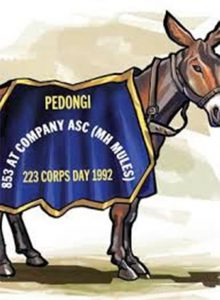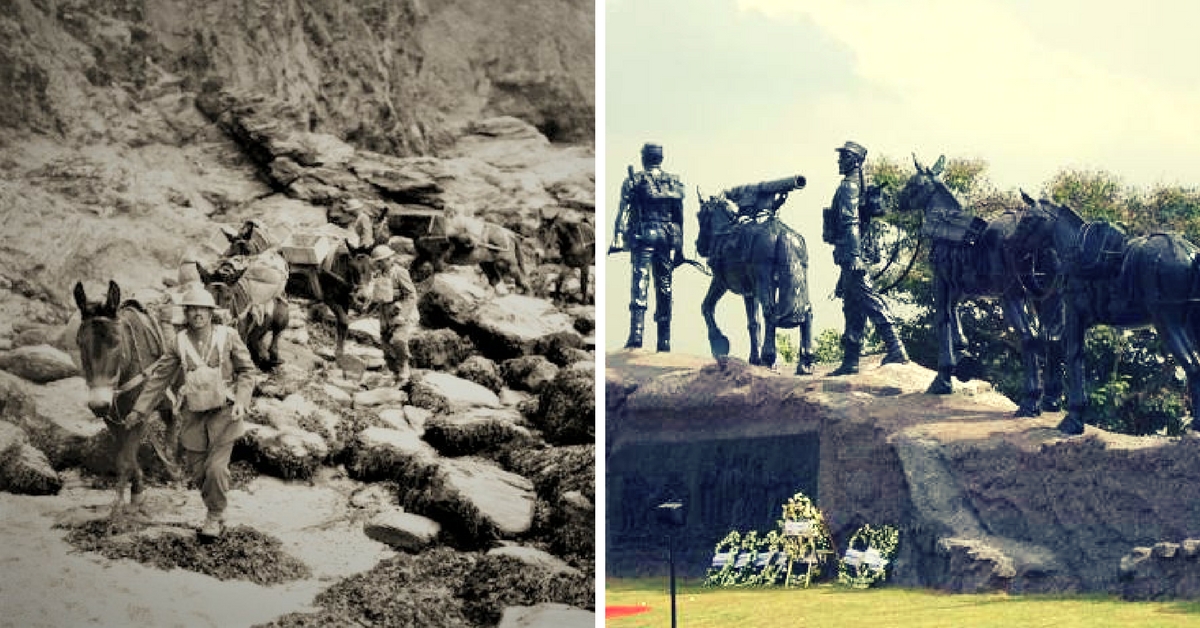Whether they are pets, mascots, or working creatures, animals have been bringing solace to the soldiers serving at the front since time immemorial.
Recently, the Indian Army honoured the contribution of animals in military service by naming its swanky new lounge at the Central Army Service Corps (ASC) officers’ mess in Delhi after an MA (Mountain Artillery) mule, Pedongi.
In the armed forces, names are a privilege reserved for horses and are rarely given to mules (who are identified by their hoof numbers). But Pedongi was no ordinary mule. Not only was she the army’s longest-serving mule, she was also the only one to be awarded a bravery citation and a ceremonial blue velvet rug by the Indian Army!

A bay mare of Spanish breed, Pedongi (initially called Hoof Number 15328) joined the army in 1962. She was a part of the the Animal Transport units under the Indian Army Service Corps. As an MA mule, her job was to work alongside troops during war to transport ammunition and other stores to forward units as well as transport casualties to military hospitals on some of the most treacherous tracks in the world.
In those days, even during peace time, the contribution of Pedongi and her fellow mules was vital in providing last-mile logistics supply to isolated army units. During winter, heavy snowfall would convert the frontier into a terrain where no vehicle (perhaps even man) could possibly go. If not for for the supplies brought by the mules, the soldiers would have been unable to stay at their outposts.
As an army officer told the Bangalore Mirror, “These mules work just as hard as the soldiers.”
Representative Image Photo Source
During her long career, Pedongi braved bullets, airstrikes and battle trenches to prove her mettle as a brave and intelligent military mule. She was highly respected and valued for her many feats, one of which has an interesting story behind it. The story goes that during the 1971 Indo-Pak war, an animal transport column including Pedongi was captured and taken along by the Pakistani forces.
However, a fortnight later, Pedongi managed to escape from the Pakistani forces. Carrying boxes of Pakistani ammunition on her back, the exhausted animal made her way back to an Indian Army outpost. Mightily pleased by her loyalty and gumption, the Animal Transport Battalion Commander reported the matter to his seniors who recommended a citation of bravery for Pedongi.
Pedongi was indeed honoured by the Indian Army but years later. In 1987, 29-year-old Pedongi was stationed at 853 AT Company ASC when she came to the notice of Commanding Officer Maj Chunni Lal Sharma.
Usually, mules serve the army for 18-20 years. He was astonished and impressed to find out that the hardworking animal was still willing and able to serve in altitudes as high as 17,000 feet even though she was the oldest MA mule in the Indian Army!
Representative Image Photo Source
Touched by the mule’s long and loyal service, Major Sharma formally appointed Pedongi as the mascot of 53 AT Company ASC. In 1989, Pedongi’s picture also graced the ‘season’s greeting card’ of the unit. The ageing animal was later shifted to Bareilly where she spent her last years grazing in green fields and enjoying the affection of soldiers posted at the military base.
Finally, in 1992, Pedongi was specially taken to Delhi where she was presented with a bravery citation and a blue velvet ceremonial rug at the 223 Corps Day Function. She was also formally given the name Pedongi (after the town of Pedong, a battle location in North Sikkim).
The brave animal made it to the Guinness Book of World Records as the ‘Longest-Serving Military Mule’ in 1997 before passing away peacefully in Bareilly on March 25, 1998.
Interestingly, in the years just before the Kargil war, there was a proposal to disband the Animal Transport units and replace them with all-terrain vehicles. However, when war erupted in Kargil, intense shelling along the motorable roads in Drass and Kargil made logistics support to remote outposts by vehicles and even helicopters impossible.
The Animal Transports units were the only ones who continued to work in the face of heavy shelling. The sturdy and sure-footed mules could go through rugged ridges and precarious tracks on which no vehicle could reach. Unsurprisingly, the proposal to disband them was scrapped.
Representative Image Photo Source
At present, the Indian Army maintains a 6,000-strong force of mules. These Animal Transport units continue to provide a reliable mode of last-mile transport in the harsh terrain along the Indian frontier.
As an Army official told IANS, “The dauntless and loyal military mules of the Army Service Corps have enabled last-mile logistics supply in the most inhospitable conditions along our frontiers in all past wars and operations in the highest tradition of the Indian Army.”
Also Read:Our Salute to the Unsung Canine Heroes of the Indian Army
Like this story? Or have something to share? Write to us: contact@thebetterindia.com, or connect with us on Facebook and Twitter.
NEW: Click here to get positive news on WhatsApp!
If you found our stories insightful, informative, or even just enjoyable, we invite you to consider making a voluntary payment to support the work we do at The Better India. Your contribution helps us continue producing quality content that educates, inspires, and drives positive change.
Choose one of the payment options below for your contribution-
By paying for the stories you value, you directly contribute to sustaining our efforts focused on making a difference in the world. Together, let's ensure that impactful stories continue to be told and shared, enriching lives and communities alike.
Thank you for your support. Here are some frequently asked questions you might find helpful to know why you are contributing?

